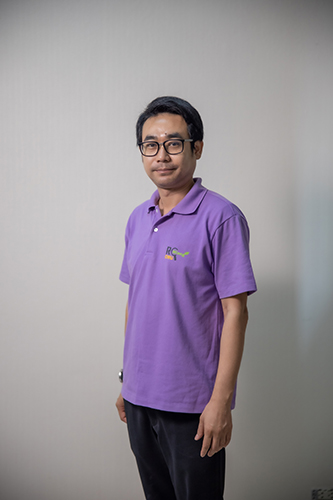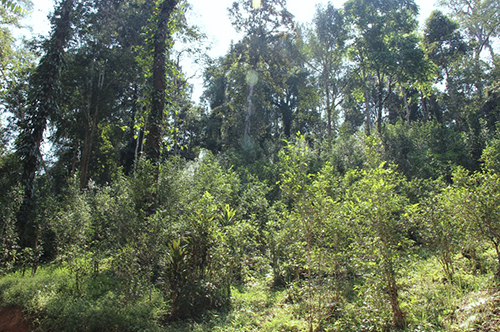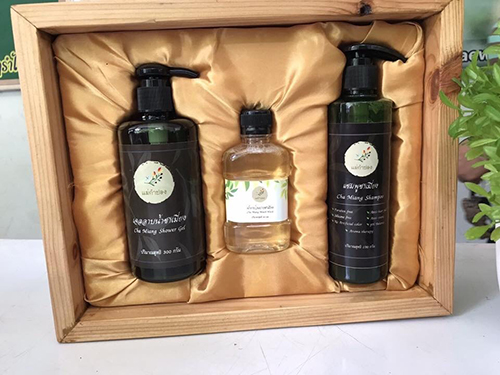Multidisciplinary researchers on-ground research
Multidisciplinary researchers at Pa Miang
Associate Professor Dr. Chartchai Khanongnuch, Director of the Research Center for Multidisciplinary Approaches to Miang, Faculty of Pharmaceuticals, Chiang Mai University

Associate Professor Dr. Chalermpong Saenjum, Faculty of Pharmacy, Chiang Mai University

Miang forest
Western and Eastern miang
Miang tea leaves

Miang tea shower gel
Miang tea eclairs
Miang for the 21st Century: A sustainable forest product
Miang tea leaves have long been used in the Lanna kingdom, mostly chewed for energy and as a palate cleanser following a meal, as its caffeine strength is in fact twice, even three times, that of coffee’s. For centuries an integral part of the cultural fabric of the region, this superfood, through research at the Research Center for Multidisciplinary Approaches to Miang, Chiang Mai University, is now proving to have vast health properties ranging from preventing cancer to being rich in antioxidants.
Through a multidisciplinary approach, the Center is working on a ‘People – Forest – Miang – Lanna’ project alongside the Faculty of Agriculture, Faculty of Economics, Faculty of Humanities, Faculty of Architecture, Faculty of Arts and the Faculty of Pharmacy, Chiang Mai University, all with the aim at developing miang as a sustainable produce to be shared with the world.
Associate Professor Dr. Chartchai Khanongnuch, Director of the Research Center for Multidisciplinary Approaches to Miang, Chiang Mai University explains that the Center was founded in 2017 in line with the university’s aim to develop excellent research in order to benefit society as a whole.
The Center’s research stations are located in Pa Pae sub district, Mae Taeng district of Chiang Mai, Baan Sri Napan, Muang district, Nan province as well as Phrae province.
“Each team of researcher is independent, while focused on the same goal,” explained Dr. Chartchai. “For instance, the arts and cultural aspects of miang is being studied by Associate Professor Woralun Boonyasurat from the Social Research Institute who is studying Phra Chao Ong Miang Temple where an old inscription has been found. We happened upon the Sri Napan community where they too had an old saying, ‘Have miang, sustain forest, have forest, sustain people’ which is fascinating as it is our exact concept.
Where is Miang from?
Having taken it upon themselves to introduce miang to the world, Dr. Chartchai and his colleagues have had to study miang in great depth and with new perspectives. Not many people realise that miang is in fact made from ‘forest tea’ or ‘Assam tea’, which is a plant found in Lanna for at least half a millennium. But how it got here remains clouded in mystery.
“Many people are confused as to why miang is often called Assam tea, thinking that it came here from there,” explained Dr. Chalermpong, “whereas in fact, miang is a local product of the Lanna people. As they migrated from southern China, a group of Tai people
“At the end of the day no one really knows the origins. When asking villagers who planted these ancient trees found deep in the forest, they say it was their grandparents, great grandparents…ancestors. This is why we are working closely with Associate Professor Woralun Boonyasurat from the Social Research Institute on the social science aspect of the plant.”
Western and Eastern Miang
Miang is still consumed across northern Thailand today and following research conducted by the Center in 22 traditional miang producing locations analysing a total of 44 types of miang, it has been discovered that miang is unique in each location, dependent on the fermentation process and fermentation time. Miang is also consumed by Tai Lue people in China’s Xishuangbanna prefecture and Tai Yai people in Myanmar. In order to conduct deeper analysis Dr. Chartchai has therefore classified miang into two categories: east and west.
“Eastern miang of the Xishuangbanna people were brought down south to Chiang Rai, Chiang Kham and Nan by the Tai Lue people. Traditionally preferring older leaves, the tastes of miang tends to have more of a sour note and following fermentation it is found that the miang has twice the normal levels of antioxidants. Whereas Western miang preferred by the Tai Yai people in Chiang Mai, Chiang Rai and Myanmar uses newer leaves which have a bitter aftertaste and is found to be a suppresser of bacteria and fungi as well as having healing properties such as helping alleviate diarrhea and healing wounds.”
The university’s researchers have already discovered that the healthy microorganisms within the miang differ depending on fermentation process and time and there is already evidence that miang can be consumed as a preventative to cancer, for instance.
To this end, Dr. Chartchai has developed ‘hygienic miang’ in the laboratory in order to conduct more controlled and in depth research.
“It was believed, in the past, that miang’s lactic bacteria was the cause of its sour taste, but we have discovered that there is also a number of yeasts and bacteria which we are now identifying by adding to pure miang leaves in order to study them further,” explained Dr. Chartchai. “We now know how much time it takes to ferment the miang to produce a certain amount of microorganisms. Knowing the taste preferences of both Eastern and Western miang consumers, we can ferment miang to meet their standards…A concern of late has been that merchants will add vinegar to sour the miang whereas we know that we can produce exact flavours to meet standards.”
“Miang is being consumed less and less today and much of it is due to the concern over lack of standards,” continued Dr. Chartchai. “In the process of fermentation it is traditional to use the feet to step on the miang, without protective wear…but when people in the city ask how their children are to eat something that has been stepped on, it is easier for them to choose not to consume it anymore.”
Miang for the 21st Century
Miang may be seen as a fading tradition, when in fact it couldn’t be more suited to the modern world. That is why the Center is working to develop new products from miang such as drinks, bakery products, and beauty products. It is even working with the Department of Material Sciences to use miang’s microorganisms to produce lactic acid in order to create bioplastic.
“Instead of trying to get the modern generation to consume miang as their ancestors did, we are fining innovative ways to entice them,” said Dr. Chartchai. “It is good for the health and shouldn’t be ignored. We are therefore developing some new products such as: miang serum which acts as a natural sunscreen against UV light, reducing spots and building collagen while healing cells. Our research shows positive signs that miang extracts prevent the reduction of collagen. We are also working alongside Fai Bakery to develop products such as the khao kam roll which we offered to HRH Princess Sirindhorn when she visited Chiang Mai one year. The next year we offered HRH a miang-filled ?clair and the following year a roll and eclair. We will keep developing new flavours.”
“Another way to get people to think differently about such a traditional product is to push the name natural pharmaceutical active ingredient to various community enterprises. We have been boasting that miang is good in such and such a way, but if we don’t push this then the villagers will continue to do things the old way as they don’t know how to change or apply what we know and consumers won’t be impressed. That is why we need to create a trademark.”